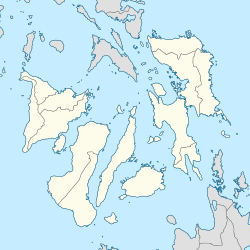
Back Metropolitanong Katedral sa Sugbo CEB Catedral metropolitana de Cebú Spanish Cathédrale métropolitaine de Cebu French Katedral Cebu ID Cattedrale di Cebu Italian Cebu Metropolitan Cathedral Dutch Catedral Metropolitana de Cebu Portuguese 宿务都主教座堂 Chinese
This article has an unclear citation style. (July 2024) |
| Cebu Metropolitan Cathedral | |
|---|---|
 The cathedral in July 2024 | |
| 10°17′45″N 123°54′10″E / 10.295814°N 123.902869°E | |
| Location | Cebu City |
| Country | Philippines |
| Denomination | Catholic |
| Tradition | Roman Rite |
| History | |
| Former name(s) | Metropolitan Cathedral and Parish of Saint Vitalis and of the Guardian Angels |
| Status | Cathedral |
| Founded | 1598 |
| Dedication | Vitalis of Milan Immaculate Conception Holy Name of Jesus |
| Dedicated | November 18, 1994 |
| Architecture | |
| Functional status | Active |
| Heritage designation | Important Cultural Property |
| Designated | March 2023[1] |
| Architectural type | Church building |
| Style | Spanish Colonial |
| Specifications | |
| Number of spires | 1 |
| Administration | |
| Province | Cebu |
| Metropolis | Cebu |
| Archdiocese | Cebu |
| Deanery | Most Holy Rosary |
| Clergy | |
| Archbishop | Jose S. Palma |
| Rector | Camilo Alia |
The Cebu Metropolitan Cathedral is the ecclesiastical seat of the Metropolitan Archdiocese of Cebu in Cebu City, Philippines.[2] The church is dedicated to Mary, under her title, Our Lady of the Immaculate Conception and to Saint Vitalis of Milan. Cebu was established as a diocese on August 14, 1595. It was elevated as a metropolitan archdiocese on April 28, 1934, with the dioceses of Dumaguete, Maasin, Tagbilaran, and Talibon as suffragans. Before being raised as a primatial church in Cebu, the church was one of the first churches in the Philippines (besides the Basilica del Santo Niño) dedicated to St. Vitalis and built near the fort in April 1565 by Miguel Lopez de Legazpi, Fray Andrés de Urdaneta and Fray Diego de Herrera.[3]
Construction of the cathedral took many years due to frequent interruptions, brought about by lack of funds and other unexpected events.[4] At one time, funds meant for the building of the cathedral were diverted to the Moro wars. The death of an incumbent bishop who spearheaded the construction/reconstruction and vacancies in the office were also factors.
The architecture of the church is typical of Spanish colonial churches in the country, namely, squat and with thick walls to withstand typhoons and other natural calamities. The facade features a trefoil-shaped pediment, which is decorated with carved relieves of floral motifs, an IHS inscription and a pair of griffins. The Spanish Royal Coat of Arms is emblazoned in low relief above the main entrance, reflecting perhaps the contribution of the Spanish monarch to its construction.
During World War II, much of the cathedral was destroyed by Allied bombings of the city. Only the belfry (built in 1835), the façade, and the walls remained. It was quickly rebuilt in the 1950s under the supervision of architect Jose Ma. Zaragosa,[4] during the incumbency of Archbishop Gabriel Reyes.
In 1982, a mausoleum was built at the back of the sacristy at the initiation of Cardinal-Archbishop Julio Rosales.[5] It serves as a final resting place for the remains of Cebu's bishops and clergy. Rosales, who died three months after inauguration of the mausoleum, is interred there along with Archbishop Manuel Salvador, a coadjutor archbishop of Cebu, Archbishop Mariano Gaviola, the archbishop of Lipa (1981–1993), and most recently, Rosales' successor, Ricardo Vidal. The remains of Bishop Juan Bautista Gorordo, the first Filipino and Cebuano bishop of Cebu, are also interred there.
The cathedral was renovated for the 75th anniversary celebration on April 28, 2009, of the elevation of Cebu into an archdiocese.[6] An application is pending at the Vatican for the cathedral's elevation into a minor basilica[3] in honor of St. Vitalis, an early Christian martyr. His feast day coincides with the day the image of the Sto. Niño de Cebu was found almost 450 years ago, as well as the anniversary of the elevation of Cebu into an archdiocese.
The present cathedral rector and moderator of the team of pastors is Camilo Alia, who was appointed in 2019. He succeeded Ruben Labajo, who was named moderator of the team of pastors of the Parish of St. Francis of Assisi in Balamban, later ordained as Auxiliary Bishop of Cebu and currently moderator of the team of pastors of the Parish of Our Lady of the Most Holy Rosary in P. Del Rosario St., Cebu City.
Endowed with the status of a full-fledged parish, the Cebu Metropolitan Cathedral comprises the civil barangays of Tinago, San Roque, Santo Niño, T. Padilla, Day-as, Tejero, and Parian, all located in the southeastern and downtown area of Cebu City.
- ^ Magsumbol, Caecent No-ot (December 3, 2023). "Cultural treasure markers for three churches pending". The Freeman. Retrieved July 8, 2024.
- ^ Metropolitan Archdiocese of Cebu, Philippines
- ^ a b Astrid Sala-Boza, “The Contested Site of the Finding of the Holy Child: Villa San Miguel or San Nicolas (Cebu El Viejo),” Philippine Quarterly of Culture Society 34, (2006): 232. www.jstor.org/stable/29792595
- ^ a b "Cebu Cathedral" Archived September 26, 2007, at the Wayback Machine
- ^ http://cebuheritage.net Archived April 27, 2012, at the Wayback Machine
- ^ "P30-M Cebu Cathedral renovation - INQUIRER.net, Philippine News for Filipinos". Archived from the original on August 30, 2009. Retrieved July 16, 2010.
© MMXXIII Rich X Search. We shall prevail. All rights reserved. Rich X Search



